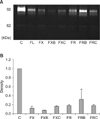Abstract
Purpose
Methods
Results
Figures and Tables
 | Fig. 1Flowcytometric detection of apoptosis in the SW480 cell line. Cells treated with the respective drug regimens and untreated controls were dual-labeled with propidium iodide (PI) and Annexin V fluorescence and analyzed by flow cytometry. (A) Untreated control; (B) FOLFOX (FX), 5-fluorouracil (5-FU) + leucovorin + oxaliplatin; (C) FOLFOX + bevacizumab (FXB); (D) FOLFOX + cetuximab (FXC); (E) FOLFIRI (FR), 5-FU + leucovorin + irinotecan; (F) FOLFIRI + bevacizumab (FRB); (G) FOLFIRI + cetuximab (FRC). Dual-parameter dot-plot of fluorescein isothiocyanate-fluorescence (x-axis) versus PI-fluorescence (y-axis) showing fluorescence intensity (log scale). Lower left quadrants, live cells; lower right quadrants, apoptotic cells; upper left quadrants, necrotic cells; upper right quadrants, apoptotic and necrotic cells. The percentage of apoptotic cells is indicated on the plots. (H) Bar diagram showing the percentage of apoptotic cells after different treatments. The percentage of apoptotic cells increased after treatment with bevacizumab-containing regimens, but decreased after treatment with combinations containing cetuximab. |
 | Fig. 2Caspase-3 activities were analyzed by Western blot analysis. SW480 cells (A) and DLD-1 cells (B) were treated with FOLFOX (FX), FOLFOX + bevacizumab (FXB), FOLFOX + cetuximab (FXC), FOLFIRI (FR), FOLFIRI + bevacizumab (FRB), or FOLFIRI + cetuximab (FRC) for 48 hours. Harvested-cell lysates were analyzed by Western blotting with an anti-caspase-3 antibody. C, control; FOLFOX (FX), 5-fluorouracil (5-FU) + leucovorin + oxaliplatin; FOLFIRI (FR), 5-FU + leucovorin + irinotecan. |
 | Fig. 3Gelatinolytic matrix metalloproteinase (MMP) activity in the SW480 cell line detected by quantitative zymography. (A) Molecular markers indicate MMP-9 and MMP-2 as 92 and 62 kDa proteins, respectively. (B) Zymographic band densities were quantified by densitometry. For all panels, data are presented ± standard errors (error bars) of three independent experiments. C, control; FX, FOLFOX (5-fluorouracil [5-FU] + leucovorin + oxaliplatin); FXB, FOLFOX + bevacizumab; FXC, FOLFOX + cetuximab; FR, FOLFIRI (5-FU + leucovorin + irinotecan); FRB, FOLFIRI + bevacizumab; FRC, FOLFIRI + cetuximab. |
Table 1

Values represent the increase in the number of apoptotic cells after treatment with the respective regimens compared with untreated controls. Data are expressed as means ± standard errors of three independent experiments.
FOLFOX, 5-fluorouracil (5-FU) + leucovorin + oxaliplatin; FOLFIRI, 5-FU + leucovorin + irinotecan; B, bevacizumab; C, cetuximab.
Table 2

Values present VEGFA mRNA levels after treatment with the respective regimen compared with untreated controls. Data are expressed as means ± errors of three independent experiments.
VEGFA, vascular endothelial growth factor A; FOLFOX, 5-fluorouracil (5-FU) + leucovorin + oxaliplatin; FOLFIRI, 5-FU + leucovorin + irinotecan; B, bevacizumab; C, cetuximab.




 ePub
ePub Citation
Citation Print
Print


 XML Download
XML Download